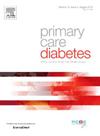振荡估计基线动脉硬度与糖尿病和糖尿病前期的正相关:一项基于人群的队列研究。
IF 2.6
4区 医学
Q3 ENDOCRINOLOGY & METABOLISM
引用次数: 0
摘要
目的:这项基于人群的大型研究旨在调查动脉僵硬是否与糖尿病/前驱糖尿病相关。方法:研究样本包括来自维生素D评估(ViDA)研究的4240名参与者(平均±SD年龄= 66 ± 8)。从2011年4月5日至2012年 11月6日,通过主动脉PWV (aPWV)和估计颈-股动脉PWV (ecfPWV)评估动脉僵硬度。通过与配药处方和国家医院出院登记的联系来确定糖尿病/前驱糖尿病的发生率。Cox比例风险回归用于评估糖尿病/前驱糖尿病风险与所选动脉硬度测量的总体和超过四分位数的关系。结果:在平均±SD随访10.5 ± 0.4年期间,470名参与者出现糖尿病/前驱糖尿病。在对潜在混杂因素进行校正后,aPWV(每SD增加的危险比(HR), 1.40, 95 % CI, 1.19-1.64)与糖尿病的发病率相关。与第1四分位数相比,aPWV的第4四分位数发生糖尿病的风险更高(HR, 1.98, 95 %CI, 1.26-3.11)(p趋势=0.01)。结论:动脉硬度,作为aPWV测量可能是一个有用的预测糖尿病的发生,可用于临床实践。本文章由计算机程序翻译,如有差异,请以英文原文为准。
Positive association of oscillometrically estimated baseline arterial stiffness with incident diabetes and prediabetes: A large population-based cohort study
Aims
This large population-based study aimed to investigate whether arterial stiffness, assessed oscillometrically, was associated with incident diabetes/prediabetes.
Methods
The study sample comprised 4240 participants from the Vitamin D Assessment (ViDA) Study (mean±SD age = 66 ± 8). Arterial stiffness was assessed from 5 April 2011–6 November 2012 by way of aortic PWV (aPWV) and estimated carotid-femoral PWV (ecfPWV). Incident diabetes/prediabetes was determined by linkage to dispensed prescription and national hospital discharge registers. Cox proportional hazards regression was used to assess the risk of diabetes/prediabetes in relation to chosen arterial stiffness measures both overall and over quartiles.
Results
During a mean±SD follow-up of 10.5 ± 0.4 years, 470 participants developed diabetes/prediabetes. Following adjustment for potential confounders, aPWV (hazard ratio (HR) per SD increase, 1.40, 95 % CI, 1.19–1.64) was associated with the incidence of diabetes. The risk of incident diabetes was, compared to the first quartile, higher in the fourth quartile of aPWV (HR, 1.98, 95 %CI, 1.26–3.11)(Ptrend=0.01).
Conclusions
Arterial stiffness, as measured by aPWV may be a useful predictor of incident diabetes that can be utilized in clinical practice.
求助全文
通过发布文献求助,成功后即可免费获取论文全文。
去求助
来源期刊

Primary Care Diabetes
ENDOCRINOLOGY & METABOLISM-PRIMARY HEALTH CARE
CiteScore
5.00
自引率
3.40%
发文量
134
审稿时长
47 days
期刊介绍:
The journal publishes original research articles and high quality reviews in the fields of clinical care, diabetes education, nutrition, health services, psychosocial research and epidemiology and other areas as far as is relevant for diabetology in a primary-care setting. The purpose of the journal is to encourage interdisciplinary research and discussion between all those who are involved in primary diabetes care on an international level. The Journal also publishes news and articles concerning the policies and activities of Primary Care Diabetes Europe and reflects the society''s aim of improving the care for people with diabetes mellitus within the primary-care setting.
 求助内容:
求助内容: 应助结果提醒方式:
应助结果提醒方式:


